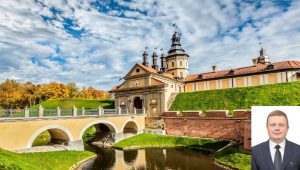A UNIQUE SPICE ON EUROPE’S DINING TABLE
Budapest makes visitors return time after time, with each new visit bringing even deeper and more complex colours and flavours to them. The Hungarian capital has something new for every 365 days of the year. Its iconic attractions, the city’s rich history, its bustling and cosmopolitan atmosphere, and the diversity of Pest and Buda, all tempt us to discover it
By His Excellency Mr. Sándor Sipos, Ambassador of Hungary to Thailand
Budapest is really exciting and ever moving no matter what time of year you visit. Each of its corners hides a special place that’s why it is almost impossible to enlist everything that is worth doing, seeing, and tasting. Explore the capital city and visit the country’s iconic attractions – many of which are World Heritage Sites – to see for yourself that Budapest is a truly picturesque city.
TREASURES OF BUDAPEST
Among the iconic sights, the Castle District is on the top of the list, not least because of its impressive architecture, rich historical past, and the panoramic views that unfold before you. One of the most outstanding sights in this district is the Fisherman’s Bastion, which offers you stunning panorama and the chance to take fabulous photos of the city. To make the moment unforgettable, visit the Matthias Church, which is full of surprises, mysteries and treasure. The church has a breathtaking interior with colours inspired by orientalism and romantic historicism. Its mystically exotic atmosphere paired with neo gothic features differentiates it from any other church. To finish your visit in this part of the city, below the Buda Castle, you can find Budapest’s unique jewellery box, the Várkert Bazár, a distinctive work of architecture offering an experience of history, culture, and nature all at the same time.
The Parliament on the Pest side bank of the Danube gives you an excellent start to explore the other part of the city, along with Kossuth Square, which should be on every traveller’s bucket list. The third largest Parliament in the world is richly decorated inside and outside and was inspired by the Houses of Parliament in London, thus, it was designed in neo-gothic style, although it also bears Renaissance and Baroque stylistic flourishes. Talking about religious sights, the largest church in the city, the St Stephen Basilica, in the heart of the city centre has a jaw-dropping view of the narrow streets of the city centre.
World-famous footballer Ferenc Puskás rests here, and it has provided backdrop for Hollywood blockbusters. Moreover, the Dohány Street Synagogue of Budapest is not only the largest Hebrew temple of Europe, but its surroundings are like a small island with a fabulous atmosphere, full of exhibitions, synagogues, cemeteries, and memorials.
Continuing our trip in the city centre, on the enchanting boulevard, on Andrássy Avenue, we can encounter the gigantic building of the Hungarian State Opera. British online magazine The Telegraph selected it as one of the world’s most beautiful concert venues. There, you can get on the Metro Line M1, which is the oldest underground railway in the continental Europe, and experience the unparalleled beauty of the metro stations.
Speaking of the squares and parks in the capital city of Hungary, the Heroes’ Square comes to everybody’s mind at first. It is famous not only for its group of sculptures depicting archangels and the greats of Hungarian history: the square is also flanked by the Art Gallery on one side and the Museum of Fine Arts on the other, which often host exciting exhibitions. Behind the Square, you can find a fairytale building, hidden among the trees, the so-called Vajdahunyad Castle in the City Park, which is today home to the Museum of Hungarian Agriculture. The castle was built on an island and can be accessed via one of four bridges.
A MUSEUM FOR EYES AND EARS
In the middle of the City Park, The House of Music Hungary, a unique and complex institution of musical initiation and the venue for the country’s first comprehensive exhibition presenting the history of music, opened in January 2022. Although Hungary is famed for its musical heritage, no multi-faceted exhibition presenting the history of Hungarian music in the context of European music had been hosted in any Hungarian institution exhibition before this one.
The iconic building, designed by Japanese star architect Sou Fujimoto, was selected from among 170 international projects, and since the announcement of the design as the winner of the architectural competition, it has attracted massive attention in international professional circles. This is confirmed, for example, by the fact that in early 2021 it was listed by CNN and the World Architecture Community as one of the ten most anticipated new buildings of the year.
EAT AND EXPLORE LIKE A LOCAL
Budapest does not let you leave without trying out the specialities of the country. You cannot skip Vásárcsarnok, Budapest’s Great Market Hall. The historic building hosts an extensive array of traditional Hungarian flavours and delights, ranging from fresh local produce, cuts of meat, down to artisanal crafts and memorabilia.
Have you ever thought of trying out the oil pressed from various seeds in western Hungary? Looking for home made honey? The market hall is a must on any checklist, and it is a bustling location that will have you immersed in exploration for hours.
You are probably hungry by now and this day should be no exception for discovering yet another incredibly flavourful traditional Hungarian dish. The options are abundant whether you prefer high-end service or the local version of the corner diner where locals go in their lunchtime to eat. After the meal, it is always a good idea to have a coffee. Just a few minutes from the Vásárcsarnok is New York Café where you can enjoy sophisticated brews and gastronomy in opulent, aristocratic surroundings.
After a long walk in the freezing cold, it never hurts to relax. Budapest is famous all over the world for its thermal spas because water comes naturally warm to the surface, thus offering good-quality thermal water to the guests.
The Széchenyi Spa is Budapest’s largest thermal bath and is worth a visit, as is the Rudas Spa at the foot of Gellért Hill, with its rooftop hot pool offering a beautiful view of the city. At the foot of Gellért Hill is the Gellért Bath, which is also very popular and one of the oldest baths in Budapest with more than 1,500 thermal springs.















